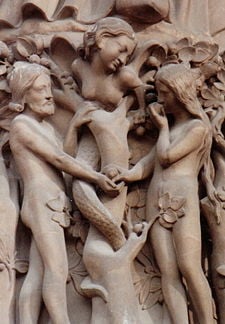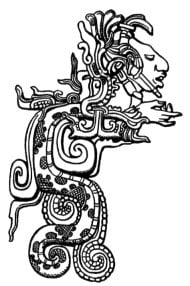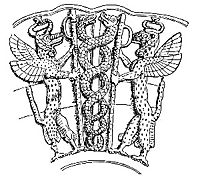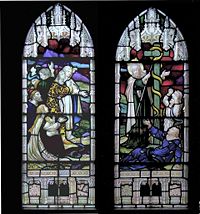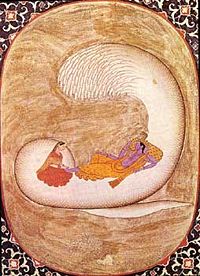Difference between revisions of "Serpent" - New World Encyclopedia
Scott Dunbar (talk | contribs) (Claimed) |
Rosie Tanabe (talk | contribs) |
||
| (15 intermediate revisions by 6 users not shown) | |||
| Line 1: | Line 1: | ||
| − | {{ | + | {{Paid}}{{Approved}}{{Submitted}}{{Images OK}}{{Copyedited}} |
| − | : | + | [[Image:France Paris Notre-Dame-Adam and Eve.jpg|thumb|right|225px|[[Adam]], [[Eve (Bible)|Eve]], and the Serpent at the entrance to [[Notre Dame de Paris|Notre Dame Cathedral]] in [[Paris]]. Medieval Christian art often depicted the Edenic Serpent as a female, thus emphasizing the Serpent's seductiveness.]] |
| − | + | '''Serpent''' (from [[Latin]]: ''serpens, serpentis'') is a word used in [[mythology|mythological]] or [[religion|religious]] contexts to denote a being that looks like a snake but has a heightened sense of intelligence. Serpents are found in the mythology of many cultures and world religions, and are associated with both negative and positive connotations. On the one hand, serpents are commonly connected with regeneration, renewal, and health (which is still implied by the modern medical symbol); yet, on the other hand, they are frequently seen in [[Judaism|Judeo]]-[[Christian]] and [[Islam|Islamic]] cultures as symbols of [[evil]] and wickedness. Such ambivalent viewpoints reflects the fascination that humanity has placed in these creatures over the ages. Overall, few cross-cultural symbols have played such a widespread role in evoking a range of attitudes from fear to loathing to admiration. | |
| − | '''Serpent''' | + | {{toc}} |
| − | |||
==General symbolism== | ==General symbolism== | ||
| − | + | The serpent is one of the oldest and most widespread [[mythology|mythological]] figures found in various cultures. It was recognized in early times that a snake's venom, like certain chemicals of plants and fungi, had the power to either heal, poison or provide expanded consciousness. The snake was often considered one of the wisest animals because of its herbal knowledge and entheogenic association. It's habitat in the earth between the roots of plants made it an animal with chthonic properties connected to the afterlife and immortality. Additionally, the way a snake sheds its skin and comes forth from the lifeless husk glistening and fresh, made it a universal symbol of renewal, rebirth and the regeneration that potentially led to immortality. | |
| − | The serpent is one of the oldest and most widespread mythological | ||
| − | + | ==Serpents in Cross-cultural Perspective== | |
| + | A large number of myths from the world's cultures involve the role of serpents. Often these serpents live in a garden and are coiled around a [[Tree of Life]]. For example, the [[Genesis]] story found in the [[Torah]] and [[Old Testament]] involves a Serpent lurking in the [[Garden of Eden]]. In Greek mythology, the Serpent/Dragon [[Ladon]] is coiled around the tree in the garden of the Hesperides protecting the entheogenic golden apples. Similarly, Níðhöggr (the dragon of Norse mythology) eats from the roots of the [[Yggdrasil]] the World Tree. Sometimes serpents and [[dragons]] were used interchangeably because the venom of the serpent is thought to have a fiery quality similar to a fire spitting dragon. In China, the Indian serpent nāga was equated with the lóng or Chinese dragon. The [[Aztec]] and Toltec serpent god [[Quetzalcoatl]] also has dragon like wings, like its equivalent in [[Mayan mythology]] Gukumatz ("feathered serpent"). Similarly, Sea serpents were giant [[cryptozoological]] creatures once believed to live in water. [[Image:YaxchilanDivineSerpent.jpg|thumb|right|200px|A prototypical Mesoamerican serpent deity.]] | ||
| − | [[ | + | Serpents and trees also play a role in the religious stories and mythology of Eastern cultures. When the [[Buddha]] sat in meditation under the Bodhi tree of Enlightenment, for example, it is said that the mighty serpent king Mucalinda rose up from his place beneath the earth and enveloped the Buddha in seven coils for seven days to protect the Buddha from a storm arose so his meditation would not be broken. |
| − | + | In [[Hinduism]], the concept of [[Kundalini]], a [[Sanskrit]] word meaning either "coiled up" or "coiling like a snake," refers to the mothering intelligence behind yogic awakening and spiritual maturation leading to altered states of consciousness. There are a number of other translations of the term usually emphasizing a more serpentine nature to the word (e.g. 'serpent power'). It has been suggested by [[Joseph Campbell]] that the symbol of snakes coiled around a staff is an ancient representation of Kundalini physiology (Campbell 1964). The staff represents the spinal column with the snake(s) being energy channels. In the case of two coiled snakes they usually cross each other seven times, a possible reference to the seven energy centers called [[chakras]]. | |
| − | The | + | [[Image:Ningizzida.jpg|thumb|left|200px|The Sumerian god [[Ningizzida]] accompanied by two [[gryphons]]. It the oldest known image of snakes coiling around an axial rod, dating from before 2000 B.C.E.]] |
| + | Sometimes the Tree of Life is represented by a staff such as those used by [[shamans]]. Examples of such staffs featuring coiled snakes in mythology are the [[Caduceus]] of [[Hermes]], the [[Rod of Asclepius]] and the Staff of [[Moses]]. The oldest known representation is that of the [[Sumerian]] fertility god [[Ningizzida]]. Ningizzida was sometimes depicted as a serpent with a human head, eventually becoming a god of healing and magic. It is the companion of [[Dumuzi]] (Tammuz) with whom it stood at the gate of heaven. In the [[Louvre]], there is a famous green [[steatite]] vase carved for king [[Gudea]] of [[Lagash]] (dated variously twenty-second century B.C.E. to twenty-first century B.C.E. with an inscription dedicated to Ningizzida. Ningizzida was the ancestor of [[Gilgamesh]], who according to the [[Epic_of Gilgamesh|epic]] dived to the bottom of the waters to retrieve the plant of life. However, while he rested from his labor, a serpent came and ate the plant and thus became immortal, whereas Gilgamesh was destined to die. | ||
| − | + | The [[Vision Serpent]] was also a symbol of rebirth in [[Mayan mythology]]. The Vision Serpent lies at the center of the world as the [[Maya]]ns conceived it. "It is in the center axis atop the [[World Tree]]. Essentially the World Tree and the Vision Serpent, representing the king, created the center axis which communicates between the spiritual and the earthly worlds or planes. It is through ritual that the king could bring the center axis into existence in the temples and create a doorway to the spiritual world, and with it power" (Schele and Friedel 1990, 68). | |
| − | In | + | In [[Egypt]], [[Ra]] and [[Atum]] ("he who completes or perfects") were the same god. ''Atum'' was associated with earth animals, including the two headed serpent god called [[Nehebkau]] ("he who harnesses the souls") who guarded the entrance to the underworld. He is often seen as the son of the snake goddess [[Renenutet]], and confused with the snake goddess [[Wadjet]]. |
| − | + | In ancient [[Gnosticism]], the image of the serpent as the embodiment of the wisdom transmitted by ''[[Sophia (gnosticism)|Sophia]]'' was an emblem used by the [[Ophite]]" sect ("Serpent People"). Additionally, the chthonic serpent was one of the earth-animals associated with the cult of [[Mithras]]. | |
| − | + | In African [[Yoruba mythology]], [[Oshunmare]] was a mythic regenerating serpent. The demi-god Aidophedo of the West African [[Ashanti]] is another a serpent biting its own tail. In [[Dahomey mythology]] of [[Benin]] in West Africa, the serpent that supports everything on its many coils was named Dan. In the [[Vodun]] of Benin and [[Haiti]] [[Ayida-Weddo]] (a.k.a. Aida-Wedo, Aido Quedo, "Rainbow-Serpent") is a spirit of fertility, rainbows and snakes, and a companion or wife to Dan, the father of all spirits. As Vodun was exported to Haiti through the slave trade, Dan became [[Damballah|Danballah]], Damballah or Damballah-Wedo. | |
| − | + | In the [[South Pacific]], the [[Rainbow Serpent]] (also known as the [[Rainbow Snake]]) is a major [[mythology|mythological]] being for [[Indigenous Australians|Aboriginal]] people across [[Australia]], although the [[creation belief|creation stories]] associated with it are best known from northern Australia. As far away as Fiji, [[Ratumaibulu]] was a serpent god who ruled the underworld (and made fruit trees bloom). | |
| − | In | ||
| − | + | In the western world, the popular view is to see the serpent as a symbol of evil, influenced by the story of [[Genesis]] in the [[Bible]] in which a Serpent (symbolizing a fallen angel) tempts [[Eve]] (the first woman). Yet, even in the Bible, there are occasional references to Serpents in a more positive light (such as when [[Jesus]] refers to himself as the Staff of Moses—a serpent). | |
| − | + | Thus, a survey of different cultural attitudes towards serpents reveals a wide variety of different interpretations regarding this mythological creature. | |
| − | + | ==Greek Mythology== | |
| − | + | Serpents figured prominently in [[Greek Mythology]], the serpent [[Hydra (constellation)|Hydra]] is a star [[constellation]] representing either the serpent thrown angrily into the sky by [[Apollo]] or the Lernaean Hydra as defeated by [[Heracles]] for one of his Twelve Labours. The constellation [[Serpens]] represents a snake being tamed by [[Ophiuchus]] the snake-handler. | |
| − | |||
| − | |||
| − | + | Ophion ("serpent," a.k.a. Ophioneus), ruled the world with Eurynome before the two of them were cast down by [[Cronus]] and [[Rhea]]. | |
| − | The | + | The [[Minoan civilization|Minoan]] Great Goddess brandished a serpent in either hand. It is not by accident that later the infant [[Heracles]], a liminal hero on the threshold between the old ways and the new Olympian world, also brandished the two serpents that "threatened" him in his cradle. The gesture is the same as that of the Cretan goddess. |
| − | + | [[Typhon]] the enemy of the Olympian gods is described as a vast grisly monster with a hundred heads and a hundred serpents issuing from his thighs, who was conquered and cast into [[Tartarus]] by [[Zeus]], or confined beneath volcanic regions, where he is said to be the cause of eruptions. Amongst his children by Echidna are [[Cerberus]] (a monstrous three-headed [[dog]] with a snake for a tail and a serpentine mane), the serpent tailed Chimaera, the serpent-like chthonic water beast Lernaean Hydra and the hundred-headed serpentine dragon Ladon. Both the Lernaean Hydra and Ladon were slain by [[Heracles]]. | |
| − | + | [[Pytho|Python]] was the earth-dragon of [[Delphi]], always represented in vase-paintings and sculptures as a serpent. [[Apollo]] slew Pytho and remade her former home his own oracle, the most famous in Classical Greece. [[Asclepius]], the son of Apollo, learned the secrets of keeping death at bay after observing one serpent bringing another (which Asclepius himself had fatally wounded) healing herbs. To prevent the entire human race from becoming immortal under Asclepius's care, Zeus killed him with a bolt of lightning. Asclepius' death at the hands of [[Zeus]] illustrates man's inability to challenge the natural order that separates mortal men from the gods. In honor of Asclepius, snakes were often used in healing rituals, and non-poisonous snakes were left to crawl on the floor in dormitories where the sick and injured slept. | |
| + | [[Image:2005-12-28_Berlin_Pergamon_museum_Statue_of_Asklepios.jpg|thumb|150px|left|Statue of Asclepius in the Pergamon Museum, [[Berlin]].]] | ||
| − | + | [[Amphisbaena]] is a mythological, ant-eating serpent with a head at each end. According to Greek mythology, amphisbaena was spawned from the blood that dripped from [[Medusa]] the [[Gorgon]]'s head as [[Perseus]] flew over the [[Libyan Desert]] with it in his hand. Medusa and the other Gorgons were vicious female monsters with sharp fangs and hair of living, venomous snakes. | |
| − | |||
| − | + | In [[Bibliotheca (Pseudo-Apollodorus)|The Library]], [[Apollodorus]] claimed that [[Athena]] gave Asclepius a vial of blood from the Gorgons. Gorgon blood had magical properties: if taken from the left side of the Gorgon, it was a fatal poison; from the right side, the blood was capable of bringing the dead back to life. | |
| − | |||
| − | |||
| − | [[ | + | [[Olympias]], the mythological mother of [[Alexander the Great]] and a princess of the primitive land of [[Epirus (region)|Epirus]], had the reputation of a snake-handler, and it was in serpent form that Zeus was said to have fathered Alexander upon her; tame snakes were still to be found at Macedonian [[History of Pella|Pella]] in the second century C.E. ([[Lucian]],<ref>[http://www.tertullian.org/rpearse/lucian/lucian_alexander.htm ''Alexander the false prophet''], Loeb Classical Library. Retrieved March 18, 2008.</ref>) and at [[Ostia]] a bas-relief shows paired coiled serpents flanking a dressed altar, symbols or embodiments of the [[Lares]] of the household, worthy of veneration (Veyne 1987). |
| − | [[ | + | ==Torah and Biblical Old Testament== |
| − | + | In the [[TaNaK|Hebrew Bible]], the speaking serpent ''(nachash)'' in the [[Garden of Eden]] (Genesis 3:1) brought forbidden knowledge, and its identity as Satan is made explicit in the later writings of the Hebrew prophets and the New Testament of the Bible. Every word the Serpent spoke was in fact true, and its words were later confirmed by [[Yahweh]] in Gen. 3:22. | |
| − | + | Though it was cursed for its role in the Garden, this was not the end of the Serpent, who continued to be venerated in the folk religion of [[Judah]] and was tolerated by official religion until the in time of king [[Hezekiah]]. | |
| − | [[ | + | A conversion of a rod to a snake and back was believed to have been experienced by [[Moses]], and later by his brother [[Aaron's rod|Aaron]] according to [[Islam]]ic, [[Christian]], and [[Jew]]ish [[hagiography]]: |
| + | [[Image:MosesandSnake.JPG|thumb|left|200px|Moses lifts up the brass snake, curing the Israelites from the venom of snake bites.]] | ||
| + | :''And the Lord said unto him, What is that in thine hand? And he said, A rod. And he said, Cast it on the ground. And he cast it on the ground, and it became a serpent; and Moses fled from before it. And the Lord said unto Moses, Put forth thine hand, and take it by the tail. And he put forth his hand and caught it and it became a rod in his hand'' ([[Exodus]] 4:2-4). | ||
| − | [[ | + | The [[Book of Numbers]] provides an origin for an archaic bronze serpent associated with Moses, with the following narratives: |
| + | :"And the Lord sent fiery serpents among the people, and they bit the people; and much people of Israel died. Therefore the people came to Moses, and said, We have sinned, for we have spoken against the Lord, and against thee; pray unto the Lord, that he take away the serpents from us. And Moses prayed for the people. And the Lord said unto Moses, Make thee a fiery serpent, and set it upon a pole: and it shall come to pass, that every one that is bitten, when he looketh upon it, shall live. And Moses made a serpent of brass, and put it upon a pole, and it came to pass, that if a serpent had bitten any man, when he beheld the serpent of brass, he lived" ([[Book of Numbers]] 21:6-9). | ||
| − | + | When the young reforming King Hezekiah came to the throne of Judah in the late eighth century: | |
| + | :"He removed the high places, and broke the images, and cut down the groves, and broke in pieces the brasen serpent that Moses had made: for unto those days the children of Israel did burn incense to it: and he called it [[Nehushtan]]." 2 Kings 18:4. | ||
| − | + | In [[Christianity]], a connection between the Serpent and [[Satan]] is strongly made, and Genesis 3:14 where God curses the serpent, is seen in that light: "And the Lord God said unto the serpent, Because thou hast done this, thou art cursed above all cattle, and above every beast of the field; upon thy belly shalt thou go, and dust shalt thou eat all the days of thy life." Some feel that this seems to indicate that the serpent had legs prior to this punishment. But if the lying serpent was in fact Satan himself (as he is called THE serpent or dragon), rather than an ordinary snake simply possessed by Satan, then the reference to crawling and dust is purely symbolic reference to his ultimate humiliation and defeat. | |
| − | |||
| − | |||
| − | + | ==New Testament== | |
| − | |||
| − | |||
| − | + | In the [[Gospel of Matthew]] 3:7, [[John the Baptist]] calls the [[Pharisee]]s and [[Saducee]]s visiting him a `brood of vipers`. Later in Matthew 23:33, [[Jesus]] himself uses this imagery, observing: "Ye serpents, ye generation of vipers, how can ye escape the damnation of Gehenna?" <ref>"Hell" is the usual translation of Jesus' word ''[[Gehenna]]''.</ref> However, there are at least a couple of passages in the [[New Testament]] that do not present the snake with negative connotation. When sending out the twelve [[Twelve Apostle|apostles]], Jesus exhorted them "Behold, I send you forth as sheep in the midst of wolves: be ye therefore wise as serpents, and harmless as doves" (Matthew 10:16). | |
| − | |||
| − | + | [[Jesus]] made a comparison between himself and the setting up of the snake on the hill in the desert by Moses: | |
| − | : | + | :And as Moses lifted up the serpent in the wilderness, even so must the Son of man be lifted up: That whosoever believeth in him should not perish, but have eternal life (John 3:14-15). |
| + | In this comparison, Jesus was not so much connecting himself to the serpent, but showing the analogy of his being a divinely provided object of faith, through which God would provide salvation, just as God provided healing to those who looked in faith to the brass serpent. The other most significant reference to the serpent in the New Testament occurs in Revelation 12:9, where the identity of the serpent in Genesis is made explicit: | ||
| + | :"The great dragon was hurled down—that ancient serpent called the devil, or Satan, who leads the whole world astray..." | ||
| + | This verse lends support to the view that the serpent is Satan himself, which helps to explain why Eve was not surprised to be spoken to by the serpent—it was not a talking snake, but a beautiful and intelligent (yet evil) angelic being. | ||
| − | + | [[Snake handling]] is a religious ritual in a small number of Christian churches in the U.S., usually characterized as rural and [[Pentecostal]]. Practitioners believe it dates to antiquity and quote the Bible to support the practice, especially: | |
| + | :"And these signs shall follow them that believe: In my name shall they cast out devils; they shall speak with new tongues. They shall take up serpents; and if they drink any deadly thing, it shall not hurt them; they shall lay hands on the sick, and they shall recover" (Mark 16:17-18). | ||
| − | + | :"Behold, I give unto you power to tread on serpents and scorpions, and over all the power of the enemy: and nothing shall by any means hurt you" (Luke 10:19). | |
| − | + | ==Cosmic serpents== | |
| − | |||
| − | |||
| − | + | The serpent, when forming a ring with its tail in its mouth, is a widespread symbol of infinity and the cyclic nature of the cosmos. The most well known version of this Serpent is the Aegypto-Greek Ourobouros, which is believed to have been inspired by the [[Milky Way]] as some a serpent of light residing in the heavens. [[Image:Anantavishnu.jpg|thumb|200px|left|[[Vishnu]] resting on Ananta-Shesha, with [[Lakshmi]] massaging his "lotus feet."]] | |
| − | |||
| − | |||
| − | |||
| − | |||
| − | + | In [[Norse mythology]], the World Serpent (or Midgard serpent) known as Jörmungandr encircled the world in the ocean's abyss biting its own tail. | |
| − | [[ | + | In [[Hindu mythology]], the God [[Vishnu]] is said to sleep while floating on the cosmic waters on the serpent Shesha. Shesha is said to hold all the planets of the universe on his hoods and to constantly sing the glories of Vishnu from all his mouths. He is sometimes referred to as "Ananta-Shesha" which means "Endless Shesha." |
| − | |||
| − | + | In pre-Columbian Central America Quetzalcoatl was sometimes depicted as biting its own tail. The mother of Quetzalcoatl was the Aztec goddess Coatlicue ("the one with the skirt of serpents"), also known as Cihuacoatl ("The Lady of the serpent"). Her function and appearance bear some resemblance with the Hindu goddess [[Kali]], who is also accompanied by serpents. Quetzalcoatl's father was Mixcoatl ("Cloud Serpent"). He was identified with the Milky Way, the stars and the heavens in several Mesoamerican cultures. | |
==Rod of Asclepius vs. Caduceus in modern medicine== | ==Rod of Asclepius vs. Caduceus in modern medicine== | ||
| − | [[Image: | + | [[Image:Caduceus.svg|thumb|The Caduceus]] |
| − | [[Image:Star of life.svg|thumb| | + | [[Image:Star of life.svg|thumb|150px|left|The Rod of Asclepius, used on modern emergency vehicles, is found at the center of the Star of Life symbol.]] |
| − | + | The symbol of snakes entwined the staffs (such as the [[Caduceus of Hermes]] and of [[Rod of Asclepius]]) have been used since ancient times with medicinal connotations (see images inset). On Hermes' caduceus, the snakes were not merely duplicated for symmetry, they were paired opposites. The wings at the head of the staff identified it as belonging to the winged messenger, Hermes, the Roman Mercury, who was the god of magic, diplomacy and [[rhetoric]], of inventions and discoveries, the protector both of merchants and that allied occupation, to the mythographers' view, of thieves. It is however Hermes' role as [[psychopomp]], the escort of newly-deceased souls to the afterlife, that explains the origin of the snakes in the caduceus since this was also the role of the [[Sumeria]]n entwined serpent god Ningizzida, with whom Hermes has sometimes been equated. | |
| − | In | + | In late antiquity, as the arcane study of [[alchemy]] developed, Mercury was understood to be the protector of those arts too, and of the occult in general. Chemistry and medicines linked the rod of Hermes with the staff of the healer Asclepius, which was wound with a serpent; it was conflated with Mercury's rod, and the modern medical symbol— which should simply be the rod of Asclepius— often became Mercury's wand of commerce. Art historian Walter J. Friedlander collected hundreds of examples of the caduceus and the rod of Asclepius (a single snake entwined the rough staff) and found that professional associations were just somewhat more likely to use the staff of Asclepius, while commercial organizations in the medical field were more likely to use the caduceus (Friedlander 1992). |
| + | |||
| + | ==Notes== | ||
| + | <references/> | ||
==References== | ==References== | ||
| − | * | + | * Campbell, Joseph. ''Occidental Mythology: the Masks of God''. Viking Press, 1964. ISBN 9780140194432 |
| − | *John Bathurst | + | * Deane, John Bathurst. ''The Worship of the Serpent.'' Mokelumne Hill Press, 1970. ISBN 9780787302795 |
| − | *Lewis Richard | + | * Farnell, Lewis Richard. ''The Cults of the Greek States''. Adamant Media Corporation, 2002. ISBN 9781402192418 |
| − | * Joseph Eddy | + | * Fontenrose, Joseph Eddy. ''Python; a study of Delphic myth and its origins''. University of California Press, 1980. ISBN 9780520040915 |
| − | * | + | * Friedlander, Walter J. ''The Golden Wand of Medicine: A History of the Caduceus Symbol in Medicine.'' Greenwood Press, 1992. ISBN 9780313280238 |
| − | *Joseph Lewis | + | * Harrison, Jane Ellen. ''Themis: A Study of the Social Origins of Greek Religion''. Peter Smith Publisher Inc., 1986. ISBN 9780844622125 |
| − | + | * Henderson, Joseph Lewis, and Maud Oakes. ''The Wisdom of the Serpent.'' Princeton University Press, 1990. ISBN 9780691020648 | |
| − | + | * Schele, Linda, and David Friedel. ''A Forest of Kings: The Untold Story of the Ancient Maya.'' New York: William Morrow, 1990. ISBN 0688074561 | |
| + | * Veyne, Paul. ''A History of Private Life : 1. From Pagan Rome to Byzantium.'' The Belknap Press, 1987. | ||
==External links== | ==External links== | ||
| − | *[http://drblayney.com/Asclepius.html | + | All links retrieved January 26, 2023. |
| − | + | *[http://drblayney.com/Asclepius.html The caduceus vs the staff of Asclepius] | |
*[http://www.mythinglinks.org/ct~dragons.html Links to further serpent myth] | *[http://www.mythinglinks.org/ct~dragons.html Links to further serpent myth] | ||
*[http://www.reptilianagenda.com/research/r073101a.shtml Nagas and Serpents] | *[http://www.reptilianagenda.com/research/r073101a.shtml Nagas and Serpents] | ||
| − | + | *[http://www.sciam.com/article.cfm?articleid=3FE89A86-E7F2-99DF-366D045A5BF3EAB1&chanId=sa027 Scientific American - Offerings to a Stone Snake Provide the Earliest Evidence of Religion] – by J. R. Minkel 01/12/06 | |
| − | *[http://www.sciam.com/article.cfm?articleid=3FE89A86-E7F2-99DF-366D045A5BF3EAB1&chanId=sa027 Scientific American - Offerings to a Stone Snake Provide the Earliest Evidence of Religion] by J. R. Minkel 01/12/06 | ||
[[Category: Philosophy and religion]] | [[Category: Philosophy and religion]] | ||
[[Category: Religion]] | [[Category: Religion]] | ||
| − | |||
{{Credit1|Serpent_(symbolism)|103986617}} | {{Credit1|Serpent_(symbolism)|103986617}} | ||
Latest revision as of 10:04, 26 January 2023
Serpent (from Latin: serpens, serpentis) is a word used in mythological or religious contexts to denote a being that looks like a snake but has a heightened sense of intelligence. Serpents are found in the mythology of many cultures and world religions, and are associated with both negative and positive connotations. On the one hand, serpents are commonly connected with regeneration, renewal, and health (which is still implied by the modern medical symbol); yet, on the other hand, they are frequently seen in Judeo-Christian and Islamic cultures as symbols of evil and wickedness. Such ambivalent viewpoints reflects the fascination that humanity has placed in these creatures over the ages. Overall, few cross-cultural symbols have played such a widespread role in evoking a range of attitudes from fear to loathing to admiration.
General symbolism
The serpent is one of the oldest and most widespread mythological figures found in various cultures. It was recognized in early times that a snake's venom, like certain chemicals of plants and fungi, had the power to either heal, poison or provide expanded consciousness. The snake was often considered one of the wisest animals because of its herbal knowledge and entheogenic association. It's habitat in the earth between the roots of plants made it an animal with chthonic properties connected to the afterlife and immortality. Additionally, the way a snake sheds its skin and comes forth from the lifeless husk glistening and fresh, made it a universal symbol of renewal, rebirth and the regeneration that potentially led to immortality.
Serpents in Cross-cultural Perspective
A large number of myths from the world's cultures involve the role of serpents. Often these serpents live in a garden and are coiled around a Tree of Life. For example, the Genesis story found in the Torah and Old Testament involves a Serpent lurking in the Garden of Eden. In Greek mythology, the Serpent/Dragon Ladon is coiled around the tree in the garden of the Hesperides protecting the entheogenic golden apples. Similarly, Níðhöggr (the dragon of Norse mythology) eats from the roots of the Yggdrasil the World Tree. Sometimes serpents and dragons were used interchangeably because the venom of the serpent is thought to have a fiery quality similar to a fire spitting dragon. In China, the Indian serpent nāga was equated with the lóng or Chinese dragon. The Aztec and Toltec serpent god Quetzalcoatl also has dragon like wings, like its equivalent in Mayan mythology Gukumatz ("feathered serpent"). Similarly, Sea serpents were giant cryptozoological creatures once believed to live in water.
Serpents and trees also play a role in the religious stories and mythology of Eastern cultures. When the Buddha sat in meditation under the Bodhi tree of Enlightenment, for example, it is said that the mighty serpent king Mucalinda rose up from his place beneath the earth and enveloped the Buddha in seven coils for seven days to protect the Buddha from a storm arose so his meditation would not be broken.
In Hinduism, the concept of Kundalini, a Sanskrit word meaning either "coiled up" or "coiling like a snake," refers to the mothering intelligence behind yogic awakening and spiritual maturation leading to altered states of consciousness. There are a number of other translations of the term usually emphasizing a more serpentine nature to the word (e.g. 'serpent power'). It has been suggested by Joseph Campbell that the symbol of snakes coiled around a staff is an ancient representation of Kundalini physiology (Campbell 1964). The staff represents the spinal column with the snake(s) being energy channels. In the case of two coiled snakes they usually cross each other seven times, a possible reference to the seven energy centers called chakras.
Sometimes the Tree of Life is represented by a staff such as those used by shamans. Examples of such staffs featuring coiled snakes in mythology are the Caduceus of Hermes, the Rod of Asclepius and the Staff of Moses. The oldest known representation is that of the Sumerian fertility god Ningizzida. Ningizzida was sometimes depicted as a serpent with a human head, eventually becoming a god of healing and magic. It is the companion of Dumuzi (Tammuz) with whom it stood at the gate of heaven. In the Louvre, there is a famous green steatite vase carved for king Gudea of Lagash (dated variously twenty-second century B.C.E. to twenty-first century B.C.E. with an inscription dedicated to Ningizzida. Ningizzida was the ancestor of Gilgamesh, who according to the epic dived to the bottom of the waters to retrieve the plant of life. However, while he rested from his labor, a serpent came and ate the plant and thus became immortal, whereas Gilgamesh was destined to die.
The Vision Serpent was also a symbol of rebirth in Mayan mythology. The Vision Serpent lies at the center of the world as the Mayans conceived it. "It is in the center axis atop the World Tree. Essentially the World Tree and the Vision Serpent, representing the king, created the center axis which communicates between the spiritual and the earthly worlds or planes. It is through ritual that the king could bring the center axis into existence in the temples and create a doorway to the spiritual world, and with it power" (Schele and Friedel 1990, 68).
In Egypt, Ra and Atum ("he who completes or perfects") were the same god. Atum was associated with earth animals, including the two headed serpent god called Nehebkau ("he who harnesses the souls") who guarded the entrance to the underworld. He is often seen as the son of the snake goddess Renenutet, and confused with the snake goddess Wadjet.
In ancient Gnosticism, the image of the serpent as the embodiment of the wisdom transmitted by Sophia was an emblem used by the Ophite" sect ("Serpent People"). Additionally, the chthonic serpent was one of the earth-animals associated with the cult of Mithras.
In African Yoruba mythology, Oshunmare was a mythic regenerating serpent. The demi-god Aidophedo of the West African Ashanti is another a serpent biting its own tail. In Dahomey mythology of Benin in West Africa, the serpent that supports everything on its many coils was named Dan. In the Vodun of Benin and Haiti Ayida-Weddo (a.k.a. Aida-Wedo, Aido Quedo, "Rainbow-Serpent") is a spirit of fertility, rainbows and snakes, and a companion or wife to Dan, the father of all spirits. As Vodun was exported to Haiti through the slave trade, Dan became Danballah, Damballah or Damballah-Wedo.
In the South Pacific, the Rainbow Serpent (also known as the Rainbow Snake) is a major mythological being for Aboriginal people across Australia, although the creation stories associated with it are best known from northern Australia. As far away as Fiji, Ratumaibulu was a serpent god who ruled the underworld (and made fruit trees bloom).
In the western world, the popular view is to see the serpent as a symbol of evil, influenced by the story of Genesis in the Bible in which a Serpent (symbolizing a fallen angel) tempts Eve (the first woman). Yet, even in the Bible, there are occasional references to Serpents in a more positive light (such as when Jesus refers to himself as the Staff of Moses—a serpent).
Thus, a survey of different cultural attitudes towards serpents reveals a wide variety of different interpretations regarding this mythological creature.
Greek Mythology
Serpents figured prominently in Greek Mythology, the serpent Hydra is a star constellation representing either the serpent thrown angrily into the sky by Apollo or the Lernaean Hydra as defeated by Heracles for one of his Twelve Labours. The constellation Serpens represents a snake being tamed by Ophiuchus the snake-handler.
Ophion ("serpent," a.k.a. Ophioneus), ruled the world with Eurynome before the two of them were cast down by Cronus and Rhea.
The Minoan Great Goddess brandished a serpent in either hand. It is not by accident that later the infant Heracles, a liminal hero on the threshold between the old ways and the new Olympian world, also brandished the two serpents that "threatened" him in his cradle. The gesture is the same as that of the Cretan goddess.
Typhon the enemy of the Olympian gods is described as a vast grisly monster with a hundred heads and a hundred serpents issuing from his thighs, who was conquered and cast into Tartarus by Zeus, or confined beneath volcanic regions, where he is said to be the cause of eruptions. Amongst his children by Echidna are Cerberus (a monstrous three-headed dog with a snake for a tail and a serpentine mane), the serpent tailed Chimaera, the serpent-like chthonic water beast Lernaean Hydra and the hundred-headed serpentine dragon Ladon. Both the Lernaean Hydra and Ladon were slain by Heracles.
Python was the earth-dragon of Delphi, always represented in vase-paintings and sculptures as a serpent. Apollo slew Pytho and remade her former home his own oracle, the most famous in Classical Greece. Asclepius, the son of Apollo, learned the secrets of keeping death at bay after observing one serpent bringing another (which Asclepius himself had fatally wounded) healing herbs. To prevent the entire human race from becoming immortal under Asclepius's care, Zeus killed him with a bolt of lightning. Asclepius' death at the hands of Zeus illustrates man's inability to challenge the natural order that separates mortal men from the gods. In honor of Asclepius, snakes were often used in healing rituals, and non-poisonous snakes were left to crawl on the floor in dormitories where the sick and injured slept.
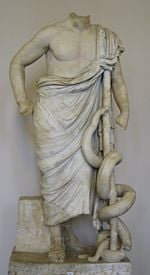
Amphisbaena is a mythological, ant-eating serpent with a head at each end. According to Greek mythology, amphisbaena was spawned from the blood that dripped from Medusa the Gorgon's head as Perseus flew over the Libyan Desert with it in his hand. Medusa and the other Gorgons were vicious female monsters with sharp fangs and hair of living, venomous snakes.
In The Library, Apollodorus claimed that Athena gave Asclepius a vial of blood from the Gorgons. Gorgon blood had magical properties: if taken from the left side of the Gorgon, it was a fatal poison; from the right side, the blood was capable of bringing the dead back to life.
Olympias, the mythological mother of Alexander the Great and a princess of the primitive land of Epirus, had the reputation of a snake-handler, and it was in serpent form that Zeus was said to have fathered Alexander upon her; tame snakes were still to be found at Macedonian Pella in the second century C.E. (Lucian,[1]) and at Ostia a bas-relief shows paired coiled serpents flanking a dressed altar, symbols or embodiments of the Lares of the household, worthy of veneration (Veyne 1987).
==Torah and Biblical Old Testament==
In the Hebrew Bible, the speaking serpent (nachash) in the Garden of Eden (Genesis 3:1) brought forbidden knowledge, and its identity as Satan is made explicit in the later writings of the Hebrew prophets and the New Testament of the Bible. Every word the Serpent spoke was in fact true, and its words were later confirmed by Yahweh in Gen. 3:22. Though it was cursed for its role in the Garden, this was not the end of the Serpent, who continued to be venerated in the folk religion of Judah and was tolerated by official religion until the in time of king Hezekiah.
A conversion of a rod to a snake and back was believed to have been experienced by Moses, and later by his brother Aaron according to Islamic, Christian, and Jewish hagiography:
- And the Lord said unto him, What is that in thine hand? And he said, A rod. And he said, Cast it on the ground. And he cast it on the ground, and it became a serpent; and Moses fled from before it. And the Lord said unto Moses, Put forth thine hand, and take it by the tail. And he put forth his hand and caught it and it became a rod in his hand (Exodus 4:2-4).
The Book of Numbers provides an origin for an archaic bronze serpent associated with Moses, with the following narratives:
- "And the Lord sent fiery serpents among the people, and they bit the people; and much people of Israel died. Therefore the people came to Moses, and said, We have sinned, for we have spoken against the Lord, and against thee; pray unto the Lord, that he take away the serpents from us. And Moses prayed for the people. And the Lord said unto Moses, Make thee a fiery serpent, and set it upon a pole: and it shall come to pass, that every one that is bitten, when he looketh upon it, shall live. And Moses made a serpent of brass, and put it upon a pole, and it came to pass, that if a serpent had bitten any man, when he beheld the serpent of brass, he lived" (Book of Numbers 21:6-9).
When the young reforming King Hezekiah came to the throne of Judah in the late eighth century:
- "He removed the high places, and broke the images, and cut down the groves, and broke in pieces the brasen serpent that Moses had made: for unto those days the children of Israel did burn incense to it: and he called it Nehushtan." 2 Kings 18:4.
In Christianity, a connection between the Serpent and Satan is strongly made, and Genesis 3:14 where God curses the serpent, is seen in that light: "And the Lord God said unto the serpent, Because thou hast done this, thou art cursed above all cattle, and above every beast of the field; upon thy belly shalt thou go, and dust shalt thou eat all the days of thy life." Some feel that this seems to indicate that the serpent had legs prior to this punishment. But if the lying serpent was in fact Satan himself (as he is called THE serpent or dragon), rather than an ordinary snake simply possessed by Satan, then the reference to crawling and dust is purely symbolic reference to his ultimate humiliation and defeat.
New Testament
In the Gospel of Matthew 3:7, John the Baptist calls the Pharisees and Saducees visiting him a `brood of vipers`. Later in Matthew 23:33, Jesus himself uses this imagery, observing: "Ye serpents, ye generation of vipers, how can ye escape the damnation of Gehenna?" [2] However, there are at least a couple of passages in the New Testament that do not present the snake with negative connotation. When sending out the twelve apostles, Jesus exhorted them "Behold, I send you forth as sheep in the midst of wolves: be ye therefore wise as serpents, and harmless as doves" (Matthew 10:16).
Jesus made a comparison between himself and the setting up of the snake on the hill in the desert by Moses:
- And as Moses lifted up the serpent in the wilderness, even so must the Son of man be lifted up: That whosoever believeth in him should not perish, but have eternal life (John 3:14-15).
In this comparison, Jesus was not so much connecting himself to the serpent, but showing the analogy of his being a divinely provided object of faith, through which God would provide salvation, just as God provided healing to those who looked in faith to the brass serpent. The other most significant reference to the serpent in the New Testament occurs in Revelation 12:9, where the identity of the serpent in Genesis is made explicit:
- "The great dragon was hurled down—that ancient serpent called the devil, or Satan, who leads the whole world astray..."
This verse lends support to the view that the serpent is Satan himself, which helps to explain why Eve was not surprised to be spoken to by the serpent—it was not a talking snake, but a beautiful and intelligent (yet evil) angelic being.
Snake handling is a religious ritual in a small number of Christian churches in the U.S., usually characterized as rural and Pentecostal. Practitioners believe it dates to antiquity and quote the Bible to support the practice, especially:
- "And these signs shall follow them that believe: In my name shall they cast out devils; they shall speak with new tongues. They shall take up serpents; and if they drink any deadly thing, it shall not hurt them; they shall lay hands on the sick, and they shall recover" (Mark 16:17-18).
- "Behold, I give unto you power to tread on serpents and scorpions, and over all the power of the enemy: and nothing shall by any means hurt you" (Luke 10:19).
Cosmic serpents
The serpent, when forming a ring with its tail in its mouth, is a widespread symbol of infinity and the cyclic nature of the cosmos. The most well known version of this Serpent is the Aegypto-Greek Ourobouros, which is believed to have been inspired by the Milky Way as some a serpent of light residing in the heavens.
In Norse mythology, the World Serpent (or Midgard serpent) known as Jörmungandr encircled the world in the ocean's abyss biting its own tail.
In Hindu mythology, the God Vishnu is said to sleep while floating on the cosmic waters on the serpent Shesha. Shesha is said to hold all the planets of the universe on his hoods and to constantly sing the glories of Vishnu from all his mouths. He is sometimes referred to as "Ananta-Shesha" which means "Endless Shesha."
In pre-Columbian Central America Quetzalcoatl was sometimes depicted as biting its own tail. The mother of Quetzalcoatl was the Aztec goddess Coatlicue ("the one with the skirt of serpents"), also known as Cihuacoatl ("The Lady of the serpent"). Her function and appearance bear some resemblance with the Hindu goddess Kali, who is also accompanied by serpents. Quetzalcoatl's father was Mixcoatl ("Cloud Serpent"). He was identified with the Milky Way, the stars and the heavens in several Mesoamerican cultures.
Rod of Asclepius vs. Caduceus in modern medicine
The symbol of snakes entwined the staffs (such as the Caduceus of Hermes and of Rod of Asclepius) have been used since ancient times with medicinal connotations (see images inset). On Hermes' caduceus, the snakes were not merely duplicated for symmetry, they were paired opposites. The wings at the head of the staff identified it as belonging to the winged messenger, Hermes, the Roman Mercury, who was the god of magic, diplomacy and rhetoric, of inventions and discoveries, the protector both of merchants and that allied occupation, to the mythographers' view, of thieves. It is however Hermes' role as psychopomp, the escort of newly-deceased souls to the afterlife, that explains the origin of the snakes in the caduceus since this was also the role of the Sumerian entwined serpent god Ningizzida, with whom Hermes has sometimes been equated.
In late antiquity, as the arcane study of alchemy developed, Mercury was understood to be the protector of those arts too, and of the occult in general. Chemistry and medicines linked the rod of Hermes with the staff of the healer Asclepius, which was wound with a serpent; it was conflated with Mercury's rod, and the modern medical symbol— which should simply be the rod of Asclepius— often became Mercury's wand of commerce. Art historian Walter J. Friedlander collected hundreds of examples of the caduceus and the rod of Asclepius (a single snake entwined the rough staff) and found that professional associations were just somewhat more likely to use the staff of Asclepius, while commercial organizations in the medical field were more likely to use the caduceus (Friedlander 1992).
Notes
- ↑ Alexander the false prophet, Loeb Classical Library. Retrieved March 18, 2008.
- ↑ "Hell" is the usual translation of Jesus' word Gehenna.
ReferencesISBN links support NWE through referral fees
- Campbell, Joseph. Occidental Mythology: the Masks of God. Viking Press, 1964. ISBN 9780140194432
- Deane, John Bathurst. The Worship of the Serpent. Mokelumne Hill Press, 1970. ISBN 9780787302795
- Farnell, Lewis Richard. The Cults of the Greek States. Adamant Media Corporation, 2002. ISBN 9781402192418
- Fontenrose, Joseph Eddy. Python; a study of Delphic myth and its origins. University of California Press, 1980. ISBN 9780520040915
- Friedlander, Walter J. The Golden Wand of Medicine: A History of the Caduceus Symbol in Medicine. Greenwood Press, 1992. ISBN 9780313280238
- Harrison, Jane Ellen. Themis: A Study of the Social Origins of Greek Religion. Peter Smith Publisher Inc., 1986. ISBN 9780844622125
- Henderson, Joseph Lewis, and Maud Oakes. The Wisdom of the Serpent. Princeton University Press, 1990. ISBN 9780691020648
- Schele, Linda, and David Friedel. A Forest of Kings: The Untold Story of the Ancient Maya. New York: William Morrow, 1990. ISBN 0688074561
- Veyne, Paul. A History of Private Life : 1. From Pagan Rome to Byzantium. The Belknap Press, 1987.
External links
All links retrieved January 26, 2023.
- The caduceus vs the staff of Asclepius
- Links to further serpent myth
- Nagas and Serpents
- Scientific American - Offerings to a Stone Snake Provide the Earliest Evidence of Religion – by J. R. Minkel 01/12/06
Credits
New World Encyclopedia writers and editors rewrote and completed the Wikipedia article in accordance with New World Encyclopedia standards. This article abides by terms of the Creative Commons CC-by-sa 3.0 License (CC-by-sa), which may be used and disseminated with proper attribution. Credit is due under the terms of this license that can reference both the New World Encyclopedia contributors and the selfless volunteer contributors of the Wikimedia Foundation. To cite this article click here for a list of acceptable citing formats.The history of earlier contributions by wikipedians is accessible to researchers here:
The history of this article since it was imported to New World Encyclopedia:
Note: Some restrictions may apply to use of individual images which are separately licensed.
